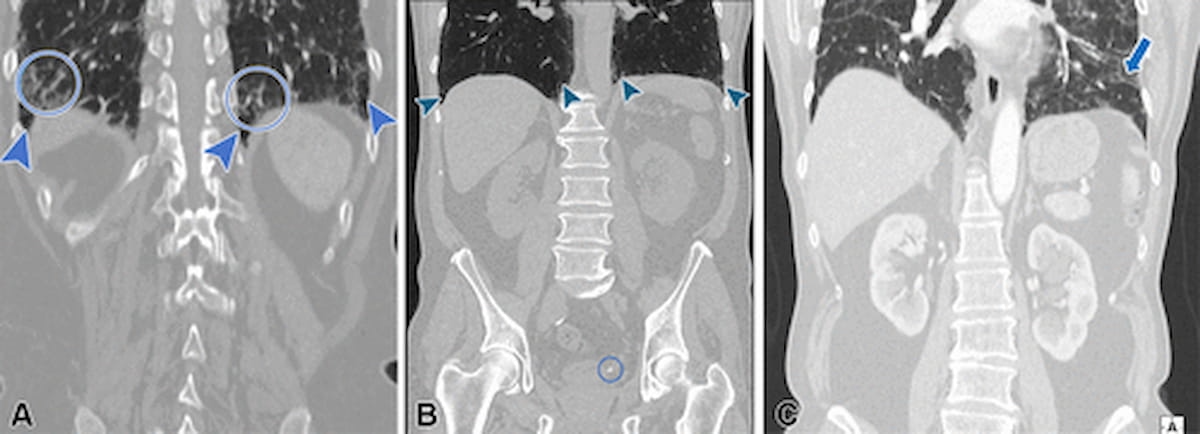New research suggests that interstitial lung abnormality (ILA) findings are commonly omitted from original reports for abdominal or thoracoabdominal computed tomography (CT) scans.
For the retrospective study, recently published in Radiology, researchers reviewed data from 21,118 patients (median age of 72) who had abdominal or thoracoabdominal CT scans in order to evaluate reporting and impact of ILAs.
The study authors found that ILAs were detected in 362 patients (1.7 percent) but also determined that ILAs were not reported in 158 of the 360 cases (43.9 percent) that had original CT reports available.
In addition to satisfaction of search that can occur with review of whole-body CT scans, the researchers noted a variety of possible factors that can contribute to the omission of ILAs in radiology reporting.
“ … Reasons for underreporting might be found in the gap between ILAs and the clinical inquiry driving clinically targeted reporting (eg, abdominal disease at the emergency department); the absence of a parenchymal window reconstruction at abdominal CT; and, potentially, the understatement of subtle pulmonary findings in a relatively old population,” wrote lead study author Nicola Sverzellati, M.D., Ph.D., who is affiliated with Scienze Radiologiche in the Department of Medicine and Surgery at the University of Parma in Parma, Italy, and colleagues.
Underreporting of ILAs was over 40 percent higher with abdominal CT review in comparison to thoracoabdominal CT interpretation (72.7 percent vs. 29.3 percent), according to the study authors. The researchers pointed out that the unreported ILAs included 41 percent of non-subpleural ILAs (28/68) as well as 55 percent of subpleural non-fibrotic ILAs (53/96) and 39.3 percent of subpleural fibrotic ILAs (77/196).
Three Key Takeaways
1. High underreporting rates for ILAs in abdominal CTs. Interstitial lung abnormalities (ILAs) were underreported in 43.9 percent of cases in which CT reports were available, with underreporting rates significantly higher for abdominal CTs (72.7 percent) compared to thoracoabdominal CTs (29.3 percent).
2. Clinical and technical gaps in reporting. Possible contributing factors for the omission of ILAs may include the lack of parenchymal window reconstruction for abdominal CTs and difficulty detecting subtle pulmonary changes in older populations.
3. Clinical impact of fibrotic ILAs. Fibrotic features, present in 61.3 percent of patients with diagnosed ILAs, were associated with a fourfold higher risk of mortality from respiratory causes, underscoring the importance of accurate detection and reporting.
The researchers pointed out that 61.3 percent of the patients with diagnosed ILAs (222/362) had evidence of fibrotic features on CT. The study authors emphasized that patients with fibrotic ILAs had a four times higher mortality risk due to respiratory causes in contrast to those without ILAs.
“Consistent with prior findings, CT fibrotic features, notably the traction bronchiectasis and bronchiectasis index, were associated with higher odds of ILA progression and increased risk of death for respiratory causes other than lung cancer,” noted Sverzellati and colleagues.
(Editor’s note: For related content, see “Study Assesses Lung CT-Based AI Models for Predicting Interstitial Lung Abnormality,” “FDA Clears CT-Based AI Software for Assessing Interstitial Lung Disease” and “MRI Study Shows Moderate to Severe Opacities Six Months After COVID-19 Pneumonia for One-Third of Exams.”)
Beyond the inherent limitations of a single-center retrospective study, the authors acknowledged that the cohort was comprised almost entirely of White patients. The researchers also conceded that the comparison of baseline abdominal or thoracoabdominal CTs to high spatial resolution CT for follow-up imaging may have affected evaluation of the progression or regression of ILAs.
